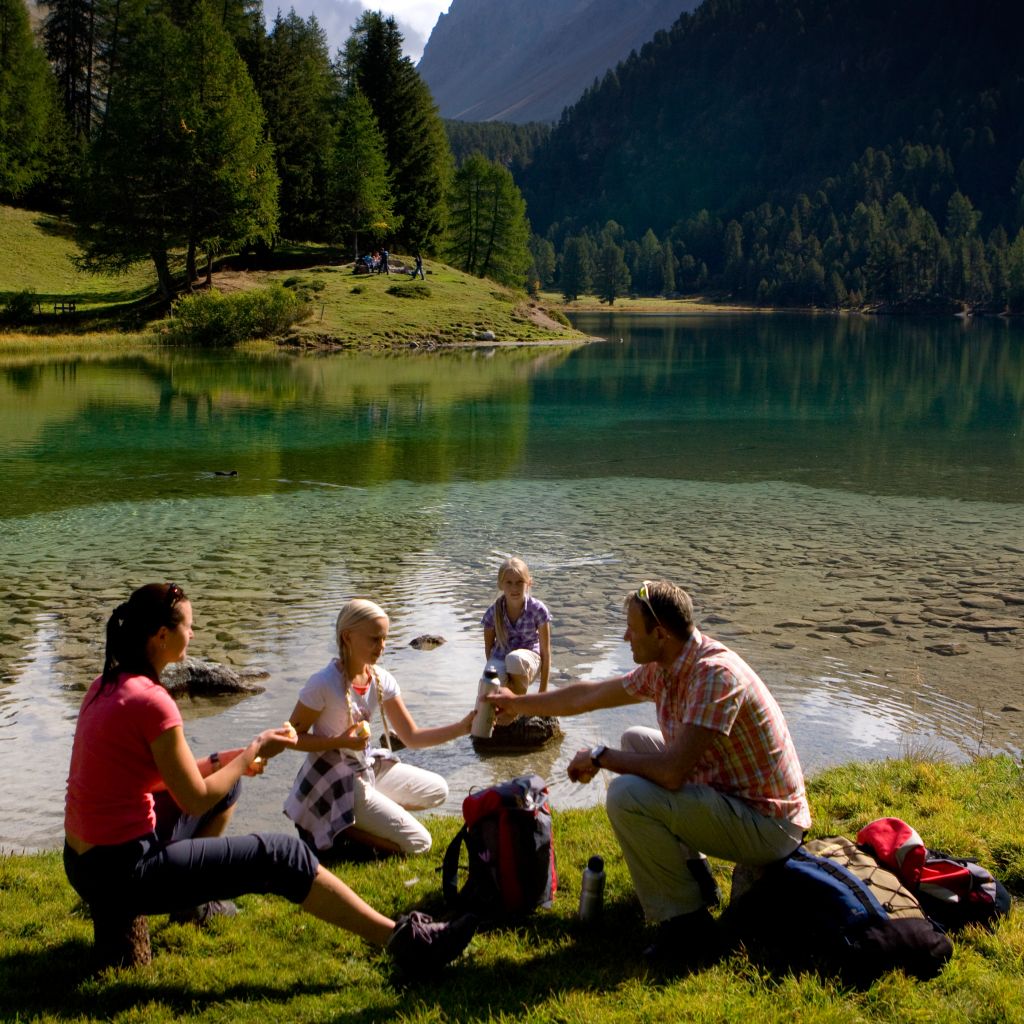For the sake of the environment, our roots and our children

The construction of an item of infrastructure like the new Albula Tunnel also influences the surrounding landscape, the environment and local people. The RhB maintains a careful approach to nature, and any interventions that are necessary take full account of local circumstances and rights to protection. Various environment-protection measures were implemented before building work began, and others will remain in force long after it is complete.
The RhB keeps the air clean
-
Use is to be made of low-emission site equipment driven by electric motors, for example.
-
All diesel-driven machines and items of equipment used for open-air tunnelling work (other than small devices) are to be fitted with particle-filter systems.
-
Low-dust procedures are to be chosen whenever dust-generating and aerosol-forming equipment and processes are in use, along with the deployment of extraction systems and/or suitable housings as required.
-
Transport routes and load-handling areas are to be compacted or regularly sprayed with water to damp down dust.
The RhB keeps the noise down:
-
Stationary items of equipment are to be electrically operated wherever possible, and fitted with noise insulation.
-
Site workers are to receive training on the sources, propagation, impact and reduction of noise.
-
Noise-intensive procedures are always to be carried out on weekdays and during normal working hours.
-
Transportation through residential areas is to be avoided wherever possible.
The RhB reduces vibrations:
-
Modern machinery conforming to the very latest technical standards is to be used in an effort to minimise vibrations as much as possible.
-
The state of endangered or previously damaged buildings has been taken into account at the planning stage, and is to be monitored accordingly.
The RhB protects the land:
-
The owners and users of local land are to be consulted regarding the temporary use of their property, as are the corresponding authorities, with detailed discussion of subsequent restoration measures.
-
These authorities are to supervise contractors throughout the construction and land-restoration procedures concerned.
-
Detailed research on contamination has been carried out in the areas near the tracks, to determine how polluted soil is to be dealt with or disposed of.
The RhB clears up afterwards:
-
The material excavated from the tunnel is to be recycled wherever possible.
-
Rubble and mud which cannot be recycled are analysed regularly for pollution-classification purposes, so that the material concerned can be disposed of correctly.
-
Waste materials are sorted at source, on the actual site, using separate containers.
The RhB transports in an eco-friendly way:
-
Transport is by rail wherever possible.
-
Transport distances are kept as short as possible.
-
The transport of non-recyclable tunnel excavation material from Preda to the landfill at Las Piazzettas takes place on a conveyor belt.
The RhB protects water resources:
-
Local water resources are to be subject to systematic monitoring throughout the construction period.
-
A system of common conduits and collection tanks is to be used to prevent any escapes of contaminated waste water. The contaminated waste water resulting from tunnel construction and other processing and installation procedures is to be subjected to multi-stage treatment and preparation before being allowed to drain away.
-
The water used to clean equipment and installation areas is to be recycled and reused wherever possible.
-
The impact of water consumption, during the construction of the tunnel, on the surrounding formations of Raibler cellular limestone is to be kept to a minimum.
The RhB looks after the forest:
-
As soon as any part of the Las Piazzettas landfill is full, it is to be turfed over with grass.
-
Forest-floor turf that has been removed is to be stored separately for subsequent restoration purposes.
-
Fragments of tree root are to be collected for use as habitats and shelter for small animals.
-
The Beverin in the area of the former dumping ground for rubble from the tunnel is being remodelled as a natural water meadow.
The RhB takes care of local flora:
-
The wooded slope on the side of Preda station facing the valley (along the Albulastrasse) is to be left untouched.
-
Restored areas are to be returned immediately to their original state using locally obtained seed or turf.
-
Important habitats, trees and hedges that border on to installation areas are to be protected to prevent damage.
The RhB protects local animal life:
-
Before work began, a local population of adders was relocated to Spinas, further down the valley, so that it would not be affected by the construction project.
-
Existing animal habitats of importance, such as stone structures, open forest, riverbanks and edges of woodland are likewise protected.
-
Construction workers receive training in how to deal with any wild animals that might stray onto the site.
The RhB looks after landscapes and views:
-
The various strips of woodland above the station at Preda are to be maintained.
-
Effort has been made at the Las Piazzettas landfill to prevent any interference with the exposed beech trees.
-
Temporarily cleared areas will be reforested once building work is complete.
The RhB looks after cultural monuments:
-
Construction work takes fully into account the extensive protection measures that apply to the UNESCO World Heritage site.
-
Painstaking documentary records are kept of altered or relocated buildings in order to guarantee that they will be reconstructed correctly.
-
All archaeological finds are to be reported immediately to the cantonal archaeological authorities, and a temporary stop placed on construction work in the area concerned.

